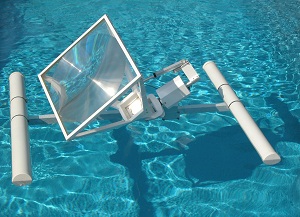Sun and water create perfect energy marriage
 An Australian company has launched a new and innovative solar technology using concentrated photovoltaic solar, secured to a floating platform on a water reservoir, in India.
An Australian company has launched a new and innovative solar technology using concentrated photovoltaic solar, secured to a floating platform on a water reservoir, in India.
Sunengy, in an effort to find a more affordable method of capturing the sun’s energy, has teamed up with India’s Tata Power on a project outside of Mumbai. The 13.5-kilowatt project is just a demonstration piece, a test of how the company’s cutting-edge technology could change energy production around the world, Sunengy CEO Phil Connor wrote in an e-mail.
Sunengy calls its product a Liquid Solar Array (LSA). Because the concentrated solar panels are mounted on a floating platform, Sunengy was able to save the cost of building heavy-duty storm-resistant land mounts, Connor said.
There was also no land acquisition costs and very limited connectivity expense as the array is floating on a water reservoir used for energy production through a hydroelectric dam.
“In this situation, there is already a large transmission line connected, but it has a limitation caused by the limited amount of water available to most hydro plants,” Connor wrote. “That means they only use the transmission line for about 30 percent of each day on average. With a large LSA system on the dam, the overall system gains another six hours or so of capacity each day. This could increase the overall energy produced by the dam by perhaps 50 percent, sometimes more.”
Solar and hydro electric power is a strong marriage of two natural resources. When the solar array is generating power, it’s essentially storing energy in the dam, which doesn’t have to release water until the sun goes down. The water also keeps the array cool, which allows it to work more efficiently.
The system would not work on the open ocean, Connor wrote, because it does need to be protected by wave breaks. However, the system is safe inside of a dam even during hurricane-force winds, according to Sunengy literature. The mirrors and sun-tracking devices turn downward and bury themselves in the water, limiting risk that they will be damaged.
While this project is simply a demonstration pilot project for Tata Power in India, Sunengy is hopeful it will be able to expand and build on reservoirs around the world.
“This will give maximum benefit without the need to change any existing infrastructure, such as the transmission lines,” Connor wrote. “There is about 800GW of hydro in the world, perhaps half of which would suit improving with the LSA system at relatively low cost. Thus the LSA is a way for many countries to increase industrial power production while reducing emissions.”
Image courtesy of Sunengy.



